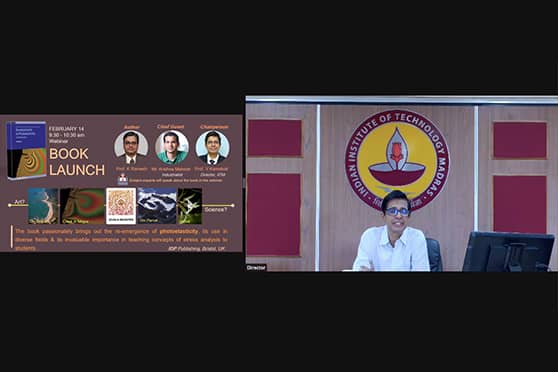UK’s Institute of Physics publishes IIT Madras professor’s digital book on photoelasticity


The UK-based Institute of Physics has published a digital book authored by IIT Madras professor K. Ramesh, who is the ‘Mahesh K. Chair Professor’ in the department of Applied Mechanics. Titled ‘Developments in Photoelasticity – A Renaissance,’ the book is based on decades of active research by K. Ramesh and his students at IIT Madras.
This digital book brings out, in one volume, the use of photoelasticity to understand complex problems such as understanding biological systems through their locomotion, which can help develop flexible robots for disaster management; improve agricultural production by understanding the stresses developed in plant roots, and the role of needle shape in epidural injections among other applications.
‘Developments in Photoelasticity – A Renaissance’ was released on February 14 at a virtual event, and was launched by Krishna Mahesh, managing director of Sundaram Brake Linings, and founder-CEO of Sundaram Medical Devices (P) Ltd, in the presence of V. Kamakoti, director, IIT Madras, Mahesh Panchagnula, dean (alumni and corporate relations), IIT Madras, and other faculty and staff of the Institute.
Diverse applications of photoelasticity from many key applications in mechanical sciences as well as neurobiology, plant biology, biomaterials, biomimetics, granular materials, soft matter, glass stress analysis, and rapid prototyping for complex model fabrication are also discussed in this book.
Speaking on the occasion Rajpal Sirohi, a Padma Shri-recipient who is from Alabama A&M University, USA, and the series editor of Advances in Optics, Photonics and Optoelectronics, highlighted the organisation of the book and said how it will be useful to both students and practising researchers in the field.
Photoelasticity is an experimental technique to reveal the stress/strain fields in models/structures through fringe patterns, especially in colour, by exploiting the phenomenon of temporary double refraction induced by in-service loading. The book presents an authoritative treatment of transmission photoelasticity, reflection photoelasticity, three-dimensional photoelasticity, photo-plasticity and digital photoelasticity.
Kamakoti said, “What is really striking about this book is the applications of this research, which range from plant biology to semiconductor packaging. This can be a game changer, when implemented in the field. I am sure many students will take this up as a career and I look forward to many start-ups coming up in this field.”
With advancements in image processing, a detailed discussion of time-tested developments in automating the data acquisition and processing forms the initial part of the book. The book assumes significance as it brings out, through various case studies, the importance of photoelastic analysis in improving the numerical simulations ranging from precision glass lens moulding used in cell phone cameras to the study of widely used interference fits in industries.
The writing style is lucid and friendly for scientists and engineers across different domains enabling them to absorb and use the technique of photoelasticity innovatively in their respective disciplines.